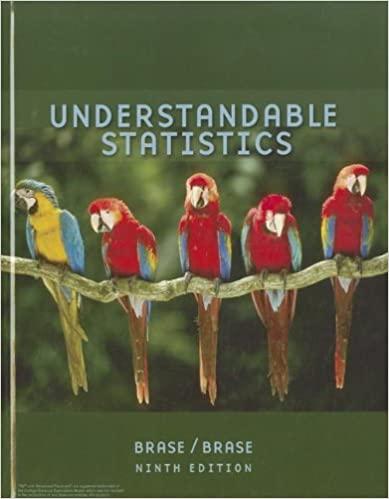Discuss each of the following topics in class or review the topics on your own. Then write
Question:
Discuss each of the following topics in class or review the topics on your own. Then write a brief but complete essay in which you summarize the main points. Please include formulas and graphs as appropriate.
1. What do we mean when we say that two variables have a strong positive (or negative) linear correlation? What would a scatter diagram for these variables look like? Is it possible that two variables could be strongly related somehow but have a low linear correlation? Explain and draw a scatter diagram to demonstrate your point.
2. What do we mean by the least-squares criterion? Give a very general description of how the least-squares criterion is involved in the construction of the least-squares line. Why do we say the least-squares line is the “best-fitting” line for the data set?
3. In this chapter, we discussed three measures for “goodness of fit” of the leastsquares line for given data. These measures were standard error of estimate, correlation coefficient, and coefficient of determination. Discuss the ways in which these measurements are different and the ways in which they are similar to each other. Be sure to include a discussion of explained variation, unexplained variation, and total variation in your answer. Draw a sketch and include appropriate formulas.
4. Look at the formula for confidence bounds for least-squares predictions. Which of the following conditions do you think will result in a shorter confidence interval for a prediction?
(a) Larger or smaller values for the standard error of estimate
(b) Larger or smaller number of data pairs
(c) A value of x near or a value of x far away from Why would a shorter confidence interval for a prediction be more desirable than a longer interval?
5. If you did not cover Section 10.4, Multiple Regression, then omit this problem. For many applications in statistics, more data lead to more accurate results. In multiple regression, we have more variables (and data) than we have in most simple regression problems. Why will this usually lead to more accurate predictions? Will additional variables always lead to more accurate predictions?
Explain your answer. Discuss the coefficient of multiple determination and its meaning in the context of multiple regression. How do we know if an explanatory variable has a statistically significant influence on the response variable? What do we mean by a regression model?
6. Use the Internet or go to the library and find a magazine or journal article in your field of major interest to which the content of this chapter could be applied. List the variables used, method of data collection, and general type of information and conclusions drawn.
Step by Step Answer:

Understandable Statistics Concepts And Methods
ISBN: 9780618986927
9th Edition
Authors: Charles Henry Brase, Corrinne Pellillo Brase





